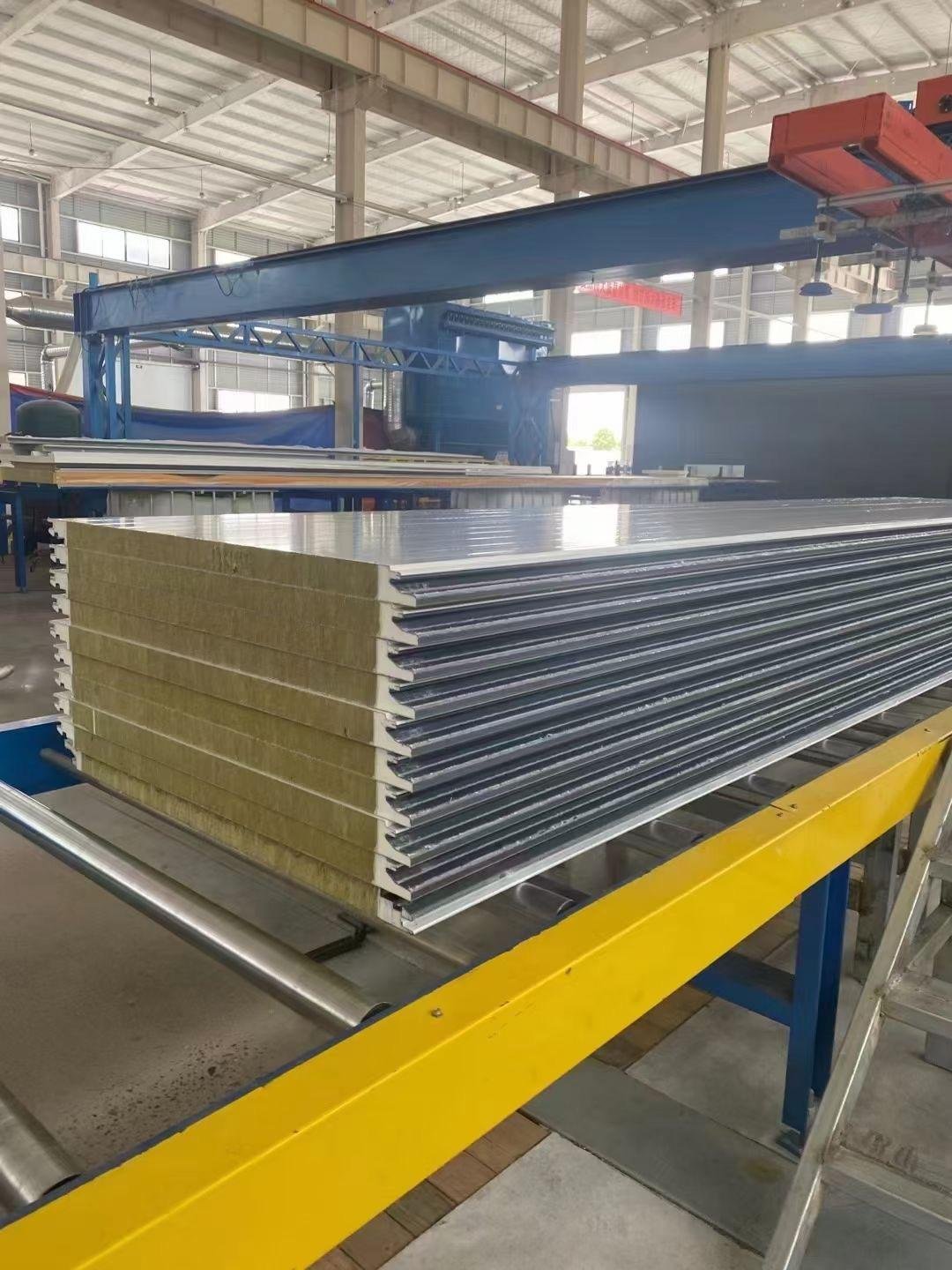
An EPS sandwich panel is a useful building material. It has an expanded polystyrene (EPS) center and strong outer layers. This design gives great insulation and support for buildings.
EPS sandwich panels are popular because they save energy. The market was worth about USD 6.5 billion in 2023. It may grow to USD 11.2 billion by 2032. This shows the need for eco-friendly materials that lower energy use and costs. Using EPS panels helps make buildings strong and energy-efficient.
Key Takeaways
EPS sandwich panels keep heat in or out, saving energy.
They are light, so they are quick and easy to install. This helps save time and money on building projects.
EPS panels last long and resist water, bugs, and heat or cold. They work well in many places.
These panels are eco-friendly. They save energy and can be recycled, helping the environment.
EPS panels can be used in homes, offices, and factories. They are a good choice for many building needs.
Composition of EPS Sandwich Panel
Core Material: EPS Foam
The middle part of an EPS panel is made of expanded polystyrene, a light and flexible material. This part is key to how the panel works. Its tiny cell structure keeps heat in or out, making it great for saving energy in buildings. Studies show that using 40% EPS bulk gives the best strength and density. This mix makes the panel strong and long-lasting for many uses.
EPS foam’s physical and heat-related features make it very useful. For instance, its ability to conduct heat is between 0.50 and 0.56 W/(m · K), helping keep indoor spaces comfortable. The foam’s strength changes with its type, reaching up to 45.23 MPa. These traits make EPS foam a dependable choice for the center of sandwich panels.
Outer Layers: Materials and Their Properties
The outside layers of an EPS panel are as important as the core. These layers are often made from steel, aluminum, or polyurethane. Each material has special benefits. Steel and aluminum are tough and resist weather, making them good for most buildings. Polyurethane is great at keeping heat in and is strong, perfect for cold storage or factories.
The material for the outer layer depends on its use. For example, polyisocyanurate (PIR) is used in business buildings because it resists fire well. Comparing these materials shows how they help EPS panels work for different building needs.
Material Type | Properties | Applications |
|---|---|---|
Steel/Aluminum | Strong, Weatherproof, Looks Good | General building use |
Polyurethane (PUR) | Great Heat Insulation, Strong | Cold storage, Factories |
Polyisocyanurate (PIR) | Fireproof, Good Heat Insulation | Business and Factory buildings |
Bonding Process: Ensuring Structural Integrity
The bonding process is key to keeping an EPS panel strong. It sticks the EPS core to the outer layers using special glue or heat. This step makes sure the panel stays together under heavy weight or extreme heat.
A well-bonded EPS panel has many benefits. It doesn’t fall apart easily, keeping its performance steady. The strong bond also helps it handle pressure, making it a tough and trustworthy building material. By focusing on bonding, makers ensure EPS panels are high-quality and work well.
Advantages of EPS Sandwich Panel
Thermal Insulation Efficiency
EPS panels are great at keeping heat in or out. The EPS core has tiny air pockets that stop heat transfer. This helps save energy in buildings. For example, EPS has an R-value of R 3.9 per inch at 75°F. It works even better in colder weather, with R-values of R-4.2 at 50°F and R-4.4 at 25°F. This makes it perfect for keeping rooms warm in cold places.
EPS performs well compared to other materials. It keeps buildings energy-efficient all year. Whether for homes, offices, or factories, EPS panels are a dependable way to save energy.
Lightweight and Easy Installation
EPS panels are light and simple to install. They weigh much less than other materials like polyisocyanurate. For instance, using EPS can make each panel 3,875 pounds lighter. In a project with 600 panels, this saves 2.9 million pounds in total weight. This makes moving and installing them easier and faster.
The foam surface and carbon-fiber connectors make setup even simpler. You can save time and effort during construction. Their light weight also reduces stress on buildings, making them safer and stronger.
Cost-Effectiveness in Construction
EPS panels are a budget-friendly choice for building projects. They insulate well, cutting down heating and cooling costs. Over time, this saves money for building owners. Their light weight also lowers shipping and labor costs, making them more affordable.
Choosing EPS panels gives you good insulation without spending too much. They last a long time, so you won’t need to replace them often. Whether for homes, offices, or factories, EPS panels are a smart and cost-effective option.
Durability and Longevity in Various Conditions
EPS sandwich panels are made to last a long time. They work well in many environments, making them a trusted choice. These panels stay strong and useful for years.
The EPS core helps make the panels durable. It doesn’t absorb water, so it avoids damage from moisture. This keeps the panels safe in wet or rainy places. The outer layers, like steel or aluminum, add extra strength. These materials don’t rust and handle bad weather well.
Some materials crack in extreme temperatures, but not EPS panels. The core stays stable in both hot and cold weather. This makes them great for areas with tough climates. You won’t see cracks or bending from temperature changes.
EPS panels also resist pests and mold. The core doesn’t attract bugs or fungi, keeping it clean. This means less maintenance is needed compared to other materials.
The bonding process adds to their strength. The core and outer layers stick together tightly. This helps the panels handle pressure and stay in good shape. They work well for walls, roofs, or cold storage.
Choosing EPS panels means picking a strong and lasting material. They handle tough conditions, making them a reliable choice for building projects.
Unique Features of EPS Sandwich Panel
Weather Resistance and Waterproofing
EPS panels are great at handling bad weather. The outer layers, made of steel or aluminum, protect against rain, snow, and humidity. These materials keep the panels strong and long-lasting. The EPS core doesn’t soak up water, stopping leaks and damage.
This mix of materials keeps buildings safe and dry. Whether it’s rainy or humid, EPS panels are a solid choice. They help buildings stay strong in tough weather.
Fire Resistance and Safety
Fire safety is very important in building design. EPS panels help with their fire-resistant features. Outer layers, like polyisocyanurate (PIR), slow flames from spreading. This gives people more time to leave safely.
Tests show EPS panels are strong and safe. For example, HPEPC cores perform better in strength tests.
Test Type | Description | Result |
|---|---|---|
Compressive Strength | Tests done using ASTM C109 standards |
Using EPS panels makes buildings safer and meets fire safety rules.
Soundproofing for Enhanced Comfort
EPS panels also block noise, making spaces quieter. The EPS core and outer layers stop sound from passing through. This is useful for homes, offices, and factories where quiet is needed.
Tests show how well EPS panels reduce noise. For instance, 110 mm thick polystyrene panels block 25.9 Rw dB of sound. Thicker panels work even better.
Material | Thickness (mm) | Sound Insulation Power Index (Rw dB) |
|---|---|---|
Polystyrene (Neopor) | 110 | 25.9 |
Polystyrene (Neopor) | 150 | 26.5 |
Mineral wool | 200 | 31.2 |
Wood fibre | 210 | 34.1 |

Adding EPS panels to buildings makes them quieter. This improves comfort and helps people focus better.
Sustainability and Eco-Friendliness
EPS sandwich panels are a smart choice for green building. They help the environment while offering useful benefits for construction. These panels are popular for eco-friendly projects.
A big benefit of EPS panels is saving energy. The EPS core keeps heat from escaping or entering. This lowers heating and cooling needs, cutting energy use. It also reduces carbon emissions and saves money on bills. Studies show buildings with EPS panels use less energy than others.
EPS panels can be recycled after use. The EPS core can be turned into new items. This reduces trash in landfills and helps the planet. Unlike some materials, EPS recycling doesn’t release harmful chemicals. This makes it safe for the environment.
Making EPS panels uses fewer resources than other materials. Factories make them with less waste and energy. This supports global efforts to save natural resources.
EPS panels are lightweight, which is another eco-friendly feature. Lighter materials need less fuel for transport, lowering emissions. This also cuts shipping costs, making them affordable and green.
Using EPS panels supports eco-friendly building methods. They save energy, can be recycled, and use fewer resources. Whether for homes, offices, or factories, these panels help build a greener world.
Applications of eps sandwich panel

Residential and Commercial Buildings
EPS sandwich panels are great for homes and offices. They help save energy by keeping indoor spaces warm or cool. This reduces the need for extra heating or air conditioning. Homeowners and businesses like them for their energy-saving benefits.
In offices and schools, EPS panels add safety and comfort. They resist fire and block noise, making them ideal for busy places. Their light weight makes them easy to install, saving time and money. Whether building a house or updating a store, EPS panels are a smart, affordable choice.
Key uses in this area:
Walls and roofs for houses.
Dividers in office buildings.
Insulated panels for schools and shops.
Industrial Facilities and Warehouses
EPS panels work well in factories and storage spaces. They keep temperatures steady, protecting machines and goods. This is important for places needing controlled environments.
These panels are strong and quick to set up. They can handle heavy loads, making them perfect for warehouses. For large projects, EPS panels save time and ensure durability. They are a reliable choice for energy-efficient industrial buildings.
Common uses in factories:
Roofs and walls for production areas.
Insulated spaces for delicate items.
Dividers in big storage centers.
Cold Storage and Refrigeration Units
EPS panels are essential for cold storage and freezers. They keep temperatures steady, which is key for storing food and medicine. Tests show they maintain temperatures between 31.8°C and 32.5°C in 600-800 minutes.
These panels are strong and insulate well, making them great for heavy-duty use. They are perfect for building refrigerators, freezers, and transport containers. Using EPS panels ensures your cold storage systems work efficiently.
Condition | Test Temp (°C) | Predicted Temp (°C) | Time to Stabilize (min) |
|---|---|---|---|
Control | 59 | 61.1 | 800-1000 |
P2, P3, P4 | 31.8 | 32.5 | 600-800 |
Main uses in cold storage:
Refrigerated warehouses for food.
Freezers for medicines.
Insulated transport boxes.
Modular and Temporary Structures
EPS sandwich panels are great for modular and temporary buildings. They are light but strong, perfect for quick setups. You can use them for portable offices, event spaces, or temporary homes. Their flexibility makes them useful for many industries.
A big benefit of EPS panels is easy installation. They are made in factories and put together on-site quickly. This saves time and lowers labor costs. Their light weight also makes them easy to transport, even to faraway places.
Temporary buildings often face tough weather. EPS panels keep the inside comfortable in any season. They stay cool in summer and warm in winter. These panels also protect against rain, wind, and moisture.
Safety is very important for temporary buildings. EPS panels often have fire-resistant outer layers. This helps them meet safety rules and makes them safe for public or work areas.
You can design EPS panels to fit your needs. They come in different sizes, colors, and styles. This lets you create buildings that look good and work well. For short-term or semi-permanent use, EPS panels are affordable and eco-friendly.
Tip: Planning a modular project? Use EPS panels for their strength, ease, and flexibility. They make building faster and better.
EPS sandwich panels have many benefits for construction projects. They keep buildings energy-efficient by stopping heat from moving through. The strong outer layers make them sturdy and able to hold weight. These panels can be used in homes, factories, and cold storage. Their light weight and eco-friendly features make them even better. Using EPS panels helps the environment and saves money while building smarter and stronger structures.
FAQ
What kinds of sandwich panels are there?
Sandwich panels have different cores like EPS, PU, rock wool, and glass wool. Each type has special features like keeping heat in, stopping fire, or blocking noise. These make them useful for different building needs.
Where are EPS panels mostly used?
EPS panels are used in homes, offices, and factories. They work well for walls, roofs, cold storage, and temporary buildings. Their light weight and good insulation make them great for saving energy.
How do EPS panels help save energy?
The EPS core stops heat from moving in or out. This keeps rooms comfy without much heating or cooling. It lowers energy use and saves money while helping the planet.
Are EPS panels good for the environment?
Yes, EPS panels are eco-friendly. They save energy, can be recycled, and need fewer materials to make. Their light weight also cuts fuel use during transport, making them a green choice.
Can EPS panels handle bad weather?
EPS panels are made for tough weather. The outer layers block rain, snow, and wind. The EPS core doesn’t soak up water, so they stay strong in any climate.







